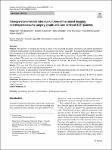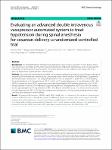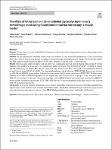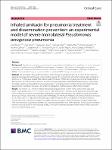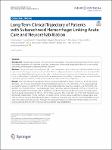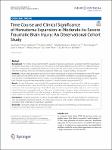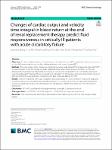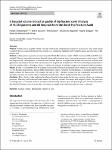Search
Author
- Osman, Ahmed I. (5)
- Daqing, Ma (3)
- Jorgensen, Ed (3)
- Li, Yan (3)
- next >
Subject
- kinh tế (26)
- Economics (12)
- programming (10)
- XRD (10)
- next >
Date issued
- 2020 - 2025 (2129)
- 2010 - 2019 (129)
- 2000 - 2009 (9)
- 1999 - 1999 (1)
Has File(s)
Search Results
Intraoperative 3D imaging has become a valued tool in assessing the quality of reduction and implant placement in orthopedic trauma surgery. In our institution, 3D imaging is used routinely since 2001. To evaluate the intraoperative findings and consequences of this technique, intraoperative revision rates in cases with 3D imaging were analyzed. |
The optimal treatment of hypotension during spinal anaesthesia is uncertain. A novel double intravenous vasopressor automated (DIVA) system reduces hypotension compared to standard care, and was subsequently modified to an advanced-DIVA (ADIVA) system. The primary objective was to compare ADIVA versus DIVA on incidence of hypotension (systolic BP (SBP) < 80% baseline). |
A tracheal foreign body is a common airway aspiration that creates an emergency, which often causes unobserved respiratory problems and requires management. Iatrogenic tracheal foreign bodies are rarely observed, which results in tracheal obstruction. If the foreign body were removed from the tracheobronchial system, it would save lives. A similar case of a tracheal foreign body was focused on, which was caused by medical glue used during preoperative computed tomography localization of pulmonary nodules. |
To investigate vascular endothelial dysfunction based on glycocalyx impairment in massive hemorrhage and to evaluate fluid therapy. |
Pseudomonas aeruginosa pneumonia is commonly treated with systemic antibiotics to ensure adequate treatment of multidrug resistant (MDR) bacteria. However, intravenous (IV) antibiotics often achieve suboptimal pulmonary concentrations. We therefore aimed to evaluate the effect of inhaled amikacin (AMK) plus IV meropenem (MEM) on bactericidal efficacy in a swine model of monolateral MDR P. aeruginosa pneumonia. |
Despite improvements in the critical care management of subarachnoid hemorrhage (SAH), a substantial number of patients still suffer from disabilities. In most areas of the world, longitudinal follow-up is not routinely performed, and the patient’s trajectory remains unknown. |
Preventing intracranial hematoma expansion has been advertised as a possible treatment opportunity in traumatic brain injury (TBI). However, the time course of hematoma expansion, and whether the expansion affects outcome, remains poorly understood. In light of this, the aim of this study was to use 3D volume rendering to determine how traumatic intracranial hematomas expand over time and evaluate its impact on outcome. |
To observe if blood return, also defined as the blood infusion test (BIT) could predict fluid responsiveness in critically ill patients with acute circulatory failure and renal replacement therapy (RRT). |
The importance of treating severely injured patients in higher-level trauma centers is undisputable. However, it is uncertain whether severely injured patients that were initially transported to a lower-level trauma center (i.e., undertriage) benefit from being transferred to a higher-level trauma center. |
Evidence for a hospital volume–outcome relationship in hip fracture surgery is inconclusive. This study aimed to analyze the association between hospital volume as a continuous parameter and several processes and outcomes of hip fracture care. |

